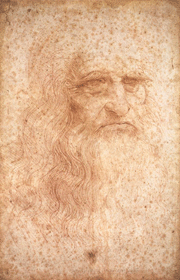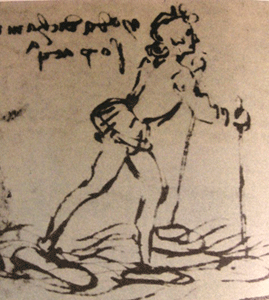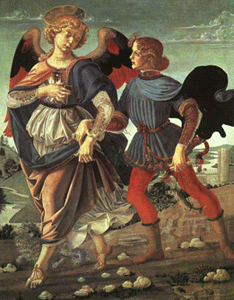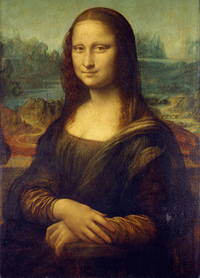|
Leonardo da Vinci
Answer
to Name
This Famous Person Game - May 2014
by Mike McLeod
|
 |
Those who correctly identified Leonardo da Vinci were: Julie and Pat Kimbrell of The Old School Antique Mall in Sylva, N.C.; Ted Carlton of Utah; Scott and Carolyn Brown of Memories Flea An’tique Mall in Prattville, Ala.; Teresa P. Bland; and Sherron Lawson of Roswell, Ga.
“It had long since come to my attention that people of accomplishment rarely sat back and let things happen to them. They went out and happened to things.”
In the Year 1550, Giorgio Vasari published a book called, Lives of the Most Eminent Painters, Sculptors and Architects. In it, he describes the great master thusly:
|

|
“The greatest gifts are often seen, in the course of nature, rained by celestial influences on human creatures; and sometimes, in supernatural fashion, beauty, grace, and talent are united beyond measure in one single person, in a manner that to whatever such an one turns his attention, his every action is so divine, that, surpassing all other men, it makes itself clearly known as a thing bestowed by God (as it is), and not acquired by human art. This was seen by all mankind in Leonardo da Vinci, in whom, besides a beauty of body never sufficiently extolled, there was an infinite grace in all his actions; and so great was his genius…that to whatever difficulties he turned his mind, he solved them with ease. In him was great bodily strength, joined to dexterity, with a spirit and courage ever royal and magnanimous; and the fame of his name so increased, that not only in his lifetime was he held in esteem, but his reputation became even greater among posterity after his death.”
It is said that Vasari was somewhat biased toward the painters, sculptors and architects of his native Florence, Italy, but even so, he is credited with being the first art historian, and his book has been used as a reference for centuries. Vasari was also a painter and architect of renown who was employed by the Medici. His talents allowed him to expertly appraise those of Leonardo da Vinci.
|

|

|
|
Leonardo da Vinci’s vision for walking on water.
|
It is said that Verrocchio used Leonardo as a model for
the angel in his painting, Tobias and the Angel.
|
Leonardo was born in the town of Vinci in Tuscany, Italy, on April 15, 1452. He was the illegitimate son of Piero da Vinci, a legal notary of some standing, and Caterina, a peasant girl. His birth name was Leonardo (or Lionardo) di ser (son of) Piero da Vinci (from the town of Vinci). His father’s standing allowed Leonardo to receive an education. At the age of 14, he was accepted into the workshop and studio of a friend of his father’s, the famous painter Verrocchio (Andrea di Cione).
It is next to impossible to find a more talented person in history than Leonardo da Vinci. Painter, illustrator, sculptor, inventor, botanist, chemist, mathematician, astronomer, anatomist, musician, geologist, engineer, cartographer—these are his skills that are on record; he undoubtedly had more. Some of his inventions—like the automatic bobbin winder, a lens grinder, and the wire tensile strength tester—were used in his day. Other inventions recorded in his journals and notebooks were for a future day: the military tank, helicopter, parachute, car, submarine, underwater breathing apparatus and a method for walking on water. He was an expert at designing gears, pulleys, link chains and so on. As Vasari reported: “He made designs of flour-mills, fulling-mills, and engines, which might be driven by the force of water.” (Fulling is the process of beating or stomping cloth, woolen particularly, to clean it.)
Even though only about 15 of his finished paintings exist today1 (his sketches are mostly on hand), Leonardo is probably revered most for his skill as an artist. The Mona Lisa and The Last Supper are his most famous works.
|

|
Lisa del Giocondo probably never saw her completed portrait since Leonardo da Vinci did not finish it in time to deliver it to her husband.
|
Leonardo da Vinci was also a great procrastinator, and he often did not finish his artwork, or it took him years to do so. The Mona Lisa was painted over four years and was still not completed on time. It never made it into the hands of Francesco del Giocondo who commissioned the painting of his wife2. Lisa del Giocondo may have seen her portrait in the early stages, but she probably never saw it completed. However, millions of people view it each year, and it is the most popular work of art in the Louvre. Leonardo was never paid for it, the most famous painting—and probably the most valuable—in the world today.
The nearly 30-foot-long The Last Supper in the Convent of Santa Maria della Grazie in Milan spanned about three years of interrupted work before completion. In his book, Vasari related a story about Leonardo being perplexed by whose face to use for Judas. After the convent’s Prior repeatedly hounded the great painter to hurry up and finish the masterpiece, Leonard is said to have told the Duke of Milan (his benefactor for the work) that he would use the Prior’s head for Judas’ if he did not find a suitable model. The Duke found this hilarious, and the Prior backed off on his demands.
“There are three classes of people: those who see, those who see when they are shown, those who do not see.”
Leonardo da Vinci died on May 2, 1519 in France, in the arms of the King Francis I who was his benefactor at that time. Before moving to France, he lived in the Vatican and worked for Pope Leo X. (His contemporaries, Michelangelo and Raphael, also worked for the Pope at that time.)
Volumes could be written about the great Leonardo da Vinci. He would have been acknowledged as a genius extraordinaire in any day or age, including ours.
“Where the spirit does not work with the hand, there is no art.”
----------------------------------
1
Leonardoda-vinci.org
2 Abcgallery.com.
All quotes are from Brainyquote.com.
Learn
about more Famous People
|